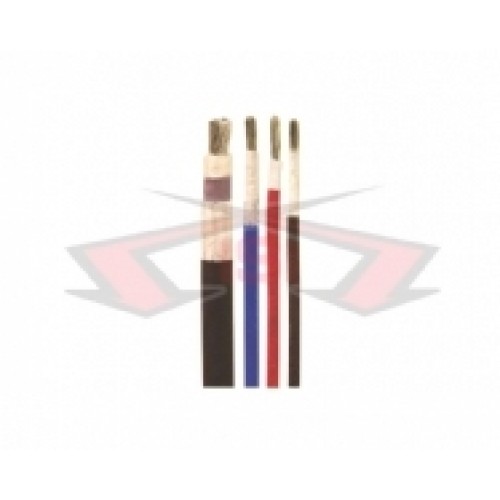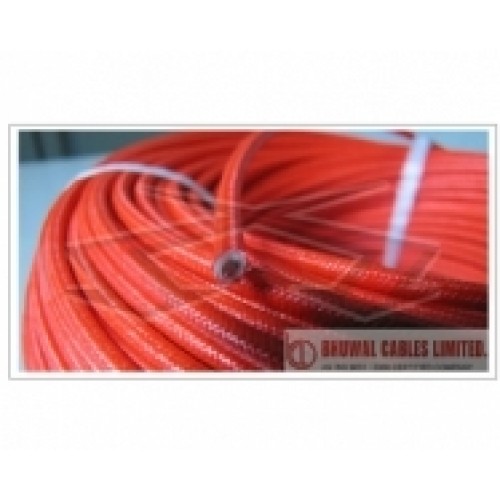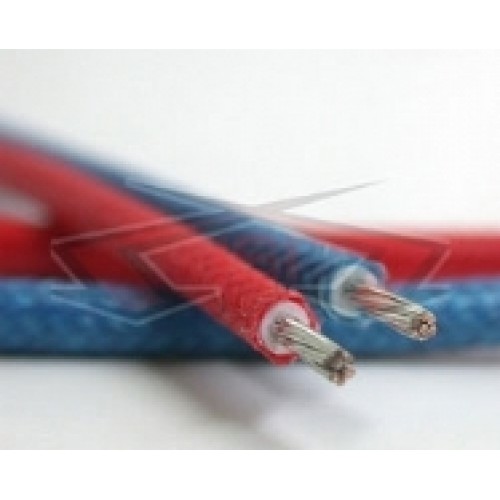High-Temperature Resistant Cables
High-Temperature Resistant Fiberglass Insulated Cables are designed for use in demanding environments with operating temperatures ranging from 300 to 450 °C. These cables are manufactured by applying a high-temperature-resistant silicone coating over fiberglass insulation material. Thanks to their high heat resistance and long lifespan, they are widely used in industrial facilities as well as residential applications.
They are commonly used in resistance connections, high-temperature furnaces, the glass and ceramic industry, iron and steel production lines, and motor windings. Their flexible structure allows for easy installation and provides extra resistance against wear and tear.
We offer a variety of high-temperature-resistant cables in different cross-sections to suit various temperature and usage conditions. You can choose the most suitable cable for your needs from our available options.
Additionally, we provide custom manufacturing options with different diameters and insulation types for special projects. For more information or to place an order, please contact us.
High-Temperature Resistant Cables
High-temperature resistant cables are a specialized type of cable commonly used in industrial and special applications. These cables are specifically designed to provide safe and reliable transmission in environments exposed to high temperatures. With durable insulation materials and heat-resistant conductor structures, they offer long-lasting and stable performance.
Such cables are widely used in power plants, metallurgy facilities, glass and ceramic production lines, the automotive industry, and petrochemical plants where high-temperature conditions prevail. They are also preferred in kitchen equipment, ovens, heating systems, and the aerospace industry.
Manufactured using materials such as fiberglass, PTFE, silicone, or specialized ceramic-based insulation, these cables maintain their insulation integrity even under extreme heat. This ensures not only resistance to high temperatures but also protection against chemicals, moisture, and mechanical wear.
We offer various types of high-temperature resistant cables suitable for different temperature levels and applications. To find the best solution for your needs, you can contact our technical team for more information.
High-Temperature Heater Cables
- Material: High-temperature heater cables are typically made from special alloys. These alloys often include nickel-chromium, kanthal, tungsten, and similar materials.
- Conductivity: Heaters are designed to conduct electrical current at high temperatures, ensuring the stable operation of heating elements.
- Durability: Reliability and durability are crucial in environments exposed to high temperatures. Therefore, high-temperature heater cables are designed to withstand prolonged and intense usage.
- Applications: High-temperature heater cables are used in various applications such as industrial furnaces, stoves, heating systems, laboratory equipment, and more.
- Variety: High-temperature heater cables come in different types and sizes, providing a wide range of options to meet various application requirements.
- Installation and Maintenance: Proper installation and periodic maintenance are important to ensure the safe and efficient operation of heaters. Suitable installation and maintenance practices can enhance the performance and longevity of heater cables.
Technical Specifications of High-Temperature Heater Cables
- Conductor: Conductors capable of withstanding high temperatures such as copper, nickel, kanthal, etc., are used.
- Insulation: Insulation materials capable of withstanding high temperatures such as XLPE, silicone, glass fiber, etc., are used.
- Outer Sheath: Outer sheath materials providing protection against abrasion and wear, such as PVC, nylon, etc., are used.
- Temperature Resistance: Cables capable of withstanding temperatures ranging from 90°C to 1300°C are available.
- Conductivity: Cables with high conductivity are preferred.
- Resistance: Cables with low resistance are preferred.
- Resistance to Wear and Tear: Cables resistant to wear and tear are preferred.
- Chemical Resistance: Cables resistant to chemicals are preferred based on the intended use.
Applications of High-Temperature Heater Cables
- Industrial Furnaces: Industrial furnaces typically operate at high temperatures and are used to process or shape materials. High-temperature heater cables are used to facilitate the heating of these furnaces.
- Stoves and Heating Systems: Industrial stoves and heating systems often operate at high temperatures. High-temperature heater cables are used as heating elements in these systems.
- Laboratory Equipment: High-temperature heater cables are preferred for laboratory equipment operating at high temperatures, especially in fields like chemistry and materials science, where precise temperature control is required.
- Plastic Processing and Extrusion: Plastic processing machines and extrusion lines operate at high temperatures. High-temperature heater cables are used in these machines for melting and shaping plastic materials.
- Metal Melting and Casting: Metal melting furnaces and casting equipment are used to melt and cast metal at high temperatures. High-temperature heater cables are commonly used in such applications.
- Automotive Industry: High-temperature applications in the automotive industry include paint booths, drying systems, and other heating applications. High-temperature heater cables are used in these systems.
Advantages of High Temperature Resistant Cable Heaters
- Long Lifespan: High temperature resistant cable heaters are made of durable materials and typically have a long service life, providing reliable performance in continuously high temperature environments.
- High Temperature Endurance: These heaters can usually withstand even very high temperature conditions, making them suitable for use in industrial ovens, stoves, and other equipment exposed to high heat.
- Precise Control and Conductivity: High temperature resistant cable heaters can be controlled with high precision and can conduct electricity consistently, making them ideal for meeting precise heating and control requirements.
- Versatility: High temperature resistant cable heaters are available in different types and sizes, providing flexibility to meet various application requirements.
- Safety: These heaters are generally made from high-quality materials and comply with strict safety standards, ensuring reliable and safe use.
- High Performance: High temperature resistant cable heaters are typically high-performing, operating efficiently with fast heating and cooling times.
- Low Maintenance Needs: When installed correctly and maintained regularly, high temperature resistant cable heaters generally require low maintenance, helping to reduce operating costs.
Features of High-Temperature Resistant Cables That Ensure High Thermal Efficiency
High-temperature resistant cables not only withstand extreme heat but also possess features that enhance energy efficiency. These cables minimize heat loss and maximize performance thanks to their specialized conductors and insulation materials.
One of the most important characteristics of these cables is the use of low-resistance conductors. This allows electrical current to be transmitted with minimal energy loss, ensuring both energy savings and improved system efficiency. They maintain conductivity even under high temperatures, providing uninterrupted power transmission.
Additionally, the high-temperature-resistant insulation materials used in these cables prevent deterioration or melting when exposed to heat. Materials such as fiberglass, silicone, and PTFE provide excellent thermal insulation, contributing to the longevity of the cables. As a result, systems require less maintenance and operate reliably for extended periods.
Moreover, the mechanical durability of these cables also enhances energy efficiency. Their ability to withstand high temperatures prevents issues such as cracking, hardening, or loss of flexibility, ensuring long-term reliability.
High-temperature resistant cables provide thermally and electrically efficient transmission, reducing energy losses to a minimum. They are widely used in industrial facilities and residential applications, optimizing system performance. For more information, feel free to contact our technical team.
Technical Details of High-Temperature Resistant Cables
High-temperature resistant cables are designed to provide reliable electrical transmission in industrial and specialized applications. These cables are made from heat-resistant materials, and their technical specifications vary depending on their usage areas and temperature levels.
Conductor Material: To ensure maximum efficiency under high-temperature conditions, conductors such as nickel-plated copper, tin-plated copper, or pure nickel are commonly used. These materials offer excellent resistance to oxidation, ensuring long-lasting performance.
Insulation Material: The insulation material is a crucial factor in determining the heat resistance of the cable. Commonly used insulation materials in high-temperature cables include:
- Fiberglass: Resistant to high temperatures and abrasion, often reinforced with a silicone coating. - PTFE (Teflon): Can withstand temperatures up to 250°C and offers high resistance to chemicals. - Silicone: Provides flexibility for easy installation and operates within a temperature range of 180-250°C. - Mica: A specialized insulation material capable of withstanding temperatures up to 1000°C, commonly used in fire-resistant cables.
Temperature Resistance: Depending on the materials used, high-temperature cables can operate within a range of 150°C to 1000°C. Choosing the correct cable rating is essential for safe and efficient performance.
Mechanical Durability: These cables are resistant to expansion and contraction caused by temperature fluctuations. Additionally, they provide excellent protection against moisture, chemicals, and mechanical wear.
Applications: High-temperature resistant cables are widely used in industries such as glass and ceramics manufacturing, steel production plants, petrochemical facilities, furnaces, motor windings, and the aerospace sector, where extreme heat conditions are present.
For assistance in selecting the most suitable high-temperature cable for your needs, feel free to contact our technical team for detailed information.
Saving Energy with High-Temperature Resistant Cables
High-temperature resistant cables not only withstand extreme heat but also help you achieve significant energy savings by enhancing energy efficiency. These cables minimize energy losses during transmission, allowing systems to operate more efficiently.
Low Energy Loss: Thanks to specially designed conductors and insulation materials, high-temperature cables transmit electrical current with low resistance. As a result, most of the energy reaches its destination without significant loss, reducing energy waste and improving system efficiency.
Heat Distribution: Cables that operate in high-temperature environments prevent excess heat from accumulating, thanks to their specialized insulation materials. This allows systems to operate more efficiently, prevents overheating issues, and reduces energy losses. This is particularly advantageous in power plants and industrial applications.
Long Lifespan and Low Maintenance Costs: High-temperature resistant cables are built to last, which means they require less maintenance over time and reduce the need for costly equipment replacements. With fewer failures and disruptions, energy losses due to outages are minimized.
Energy-Efficient Applications: High-temperature resistant cables are used in energy transmission systems, furnaces, heating devices, industrial plants, and motor windings. These cables increase energy efficiency in such applications, resulting in lower energy consumption over time.
High-temperature resistant cables are an excellent solution for saving energy and improving system efficiency. For help selecting the right cable for your needs, feel free to contact our technical team.
Technical Details to Consider When Selecting High-Temperature Resistant Cables
High-temperature resistant cables play a critical role in industrial and specialized applications. Selecting the right cable is essential for ensuring safety and achieving efficient performance. There are several technical details that should be considered when making a choice.
Operating Temperature Range: The maximum temperature the cable can withstand should be selected based on the environmental temperature conditions. High-temperature resistant cables can operate in different temperature ranges (from 150°C to 1000°C). Choosing a cable with an appropriate temperature range for the operating environment is crucial for safe and efficient performance.
Conductor Material: The conductor material used in high-temperature resistant cables directly affects the efficiency and durability of the cable. Copper, nickel-plated copper, or pure nickel conductors are commonly used. These conductors provide resistance to oxidation at high temperatures, ensuring safe and long-lasting use.
Insulation Material: The insulation material is one of the most important factors determining the heat resistance of the cable. Materials such as fiberglass, silicone, and PTFE (Teflon) protect the cable's insulation at high temperatures. The type of material used ensures the cable's longevity and efficient operation. The temperature range of the insulation material is critical for both safety and performance.
Mechanical Durability: High-temperature cables must also be mechanically durable. These cables should be resistant to expansion and contraction caused by temperature fluctuations. Additionally, they must resist chemical exposure, moisture, and mechanical wear.
Flame-Retardant and Fire-Resistant Features: High-temperature resistant cables should have flame-retardant properties, especially in applications where fire safety is a concern. The insulation material and conductor properties of the cable are crucial for fire safety. Therefore, cables with flame-retardant and non-combustible features should be preferred.
Flexibility and Easy Installation: The flexibility of high-temperature resistant cables provides ease of installation and usage. For cables used in tight spaces or difficult conditions, choosing flexible cables is important. Flexibility helps the cable endure less damage during installation and movement.
Certifications and Standards: When selecting a cable, it is important to consider compliance with international quality and safety standards. Certifications such as ISO, IEC, and UL guarantee that the cable meets specific safety and quality requirements.
There are many technical details to consider when selecting high-temperature resistant cables. Evaluating the cable's suitability for operating conditions, the characteristics of the conductor and insulation materials, and its mechanical durability ensures efficient and safe usage. You can contact our technical team to select the most suitable cable for your needs.
Operating Principle of High-Temperature Resistant Cables
High-temperature resistant cables operate by effectively conducting and safely transmitting heat. These cables are protected with special materials to withstand high temperatures, ensuring high-performance transmission. The operating principle lies in the design of the conductors and insulation materials, which are made to withstand extreme heat conditions.
Conductors: The conductors used in high-temperature cables are typically made from materials that are resistant to oxidation, such as copper, nickel-plated copper, or pure nickel. These conductors efficiently transmit electrical current while minimizing heat buildup. During heat transmission, the ability of conductor materials to withstand high temperatures ensures the safe operation of the cable.
Insulation Material: The insulation materials used in high-temperature resistant cables are carefully selected for their excellent resistance to heat. Materials such as fiberglass, silicone, PTFE, and mica help to insulate the electrical current inside the cable and prevent overheating. These insulation layers ensure the safe operation and long-lasting performance of the cable.
Thermal Transmission: Cables that operate in high temperatures are designed to prevent heat from escaping while still effectively transmitting the required amount of heat. Heat is conducted through the conductors along the cable, while the insulation materials prevent the heat from dissipating. This balance ensures the efficient operation of the cable and prevents overheating issues.
Operational Safety: High-temperature resistant cables are designed with safety measures to withstand the effects of extreme heat. The properties of the insulation layers and conductor materials allow the cable to operate safely without overheating, ensuring that systems remain efficient and have a long lifespan. These cables provide safe transmission in industrial applications, motor windings, and other systems requiring high temperatures.
The operating principle of high-temperature resistant cables relies on the selection of appropriate conductor and insulation materials. Efficient heat transmission and safe containment of heat allow the cable to operate effectively and last longer. Feel free to contact our technical team for more information on selecting the right cable for your needs.
Frequently Asked Questions
High Temperature Cables



